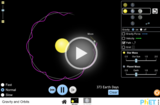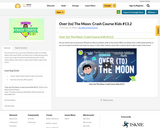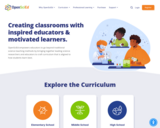
"Find out what it's like on other planets. Learn how far away the stars are. Try a fun, space-themed project."
- Subject:
- Science
- Material Type:
- Activity/Lab
- Primary Source
- Date Added:
- 05/25/2020

"Find out what it's like on other planets. Learn how far away the stars are. Try a fun, space-themed project."

This website provides users with a new Earth Science related photo daily with description.

Students will explore the relationships and patterns among the Earth, Sun, and Moon system in our solar system. Students will design, build, and test a model of a lunar rover.

In this activity, students use a paper plate to build a model that shows why lunar eclipses don’t happen during every full moon.

Move the Sun, Earth, Moon and space station to see how it affects their gravitational forces and orbital paths. Visualize the sizes and distances between different heavenly bodies, and turn off gravity to see what would happen without it!

Move the sun, earth, moon and space station to see how it affects their gravitational forces and orbital paths. Visualize the sizes and distances between different heavenly bodies, and turn off gravity to see what would happen without it!

Students use scaling from real-world data to obtain an idea of the immense size of Mars in relation to the Earth and the Moon, as well as the distances between them. Students calculate dimensions of the scaled versions of the planets, and then use balloons to represent their relative sizes and locations.

In this lesson, students learn about the physical properties of the Moon. They compare these to the properties of the Earth to determine how life would be different for astronauts living on the Moon. Using their understanding of these differences, they are asked to think about what types of products engineers would need to design for us to live comfortably on the Moon.

Can you avoid the boulder field and land safely, just before your fuel runs out, as Neil Armstrong did in 1969? Our version of this classic video game accurately simulates the real motion of the lunar lander with the correct mass, thrust, fuel consumption rate, and lunar gravity. The real lunar lander is very hard to control.

Why does the Moon not always look the same to us? Sometimes it is a big, bright, circle, but, other times, it is only a tiny sliver, if we can see it at all. The different shapes and sizes of the slivers of the Moon are referred to as its phases, and they change periodically over the course of a lunar month, which is twenty-eight days long. The phases are caused by the relative positions of the Earth, Sun, and Moon at different times during the month.

Students work in teams of two to discover the relative positions of the Earth, Sun and Moon that produce the different phases of the Moon. Groups are each given a Styrofoam ball that they attach to a pencil so that it looks like a lollipop. In this acting-out model exercise, this ball on a stick represents the Moon, the students represent the Earth and a hanging lightbulb serves as the Sun. Students move the "Moon" around them to discover the different phases. They fill in the position of the Moon and its corresponding phase in a worksheet.

Win the chance for your class to operate a Lunar Rover in a simulated mission. There will be Canadian rovers on the Moon by the end of this decade. Let’s Talk Science, Canadensys Aerospace, and Avalon Space have teamed up to give Canadian youth in Grades 6-9 the opportunity to learn about rover technology and how to plan missions on the Moon.
The Lunar Rover Research Challenge invites teams of students to pitch their mission plans for the chance to remotely operate a Canadensys rover in a lunar-like environment.
Welcome to the Lunar Rover Research Challenge!
The challenge is for students to design a rover mission to find frozen water at the South Pole of the Moon. The activity is structured as a collaborative board game or digital game where students are guided through the design process. They equip their rover with scientific instruments, choose a target, then determine where to take measurements.
The experience is designed around 5 lessons:
1: Learn about Canada’s role in the upcoming lunar missions and the benefits of space exploration to life on Earth
2: Review the mission brief and learn how to plan a rover mission on the Moon
3: Plan the mission using an iterative design process scaffolded as a collaborative board game
4: Communicate ideas and prepare for submission
5: Reflect on the team’s experience and the impact of space exploration on society
Set in the context of space exploration, this project develops students’ design thinking, teamwork, and communication skills. Students must design their research mission by considering pros and cons, and weighing risks and rewards.
This challenge can be completed without a submission to the competition.

As a weighted plastic egg is dropped into a tub of flour, students see the effect that different heights and masses of the same object have on the overall energy of that object while observing a classic example of potential (stored) energy transferred to kinetic energy (motion). The plastic egg's mass is altered by adding pennies inside it. Because the egg's shape remains constant, and only the mass and height are varied, students can directly visualize how these factors influence the amounts of energy that the eggs carry for each experiment, verified by measurement of the resulting impact craters. Students learn the equations for kinetic and potential energy and then make predictions about the depths of the resulting craters for drops of different masses and heights. They collect and graph their data, comparing it to their predictions, and verifying the relationships described by the equations. This classroom demonstration is also suitable as a small group activity.

Students learn about the Earth's only natural satellite, the Moon. They discuss the Moon's surface features and human exploration. They also learn about how engineers develop technologies to study and explore the Moon, which also helps us learn more about the Earth.

Students are introduced to the futuristic concept of the moon as a place people can inhabit. They brainstorm what people would need to live on the moon and then design a fantastic Moon colony and decide how to power it. Students use the engineering design process, which includes researching various types of energy sources and evaluating which would be best for their moon colonies.

Do you want to be an astronaut? Would you like to someday walk on the moon? Well, you better learn a little about gravity so you can escape from Earth and head into space. In this video, Sabrina chats with us about what it takes to get to the moon!

In this lesson students will understand radio waves and how they relate to the electromagnetic spectrum. They will determine wavelength, frequency, and speed of radio waves and master these concepts by completing example problems.

Open Educational Resources (OER) for K-12 Science including - lessons, videos, simulations, professional learning and on-demand teacher support.
*more is being developed so keep checking for new materials*
*CHECK GRADES OTHER THAN WHAT YOU TEACH TO FIND ADDITIONAL SK LESSON TOPICS*
"We’ve made our curriculum free for all educators because high quality instructional materials and professional learning can bridge the opportunity gap for all students. The units underwent a rigorous 18-month development process with teacher and student voices across the country informing the selection of the phenomena and each unit’s storyline. Using our curriculum, teachers have seen their students strengthen their ability to solve problems, become more curious about the world around them, and be excited to discover the wonders of science in their classrooms."

Every week Science North will provide Grade 6 teachers with a pre-recorded video and printable resource.
Teachers will be able to share these YouTube videos and resources with students weekly.
Included are classroom videos, student handouts, and offline lesson plans.
These videos and handouts can be sent to students to provide them with key concepts and activities that link to the curriculum.

This unit begins by introducing students to the historical motivation for space exploration. They learn about the International Space Station, including current and futuristic ideas that engineers are designing to propel space research. Then they learn about the physical properties of the Moon, and think about what types of products engineers would need to design in order for humans to live on the Moon. Lastly, students learn some descriptive facts about asteroids, such as their sizes and how that relates to the potential danger of an asteroid colliding with the Earth.